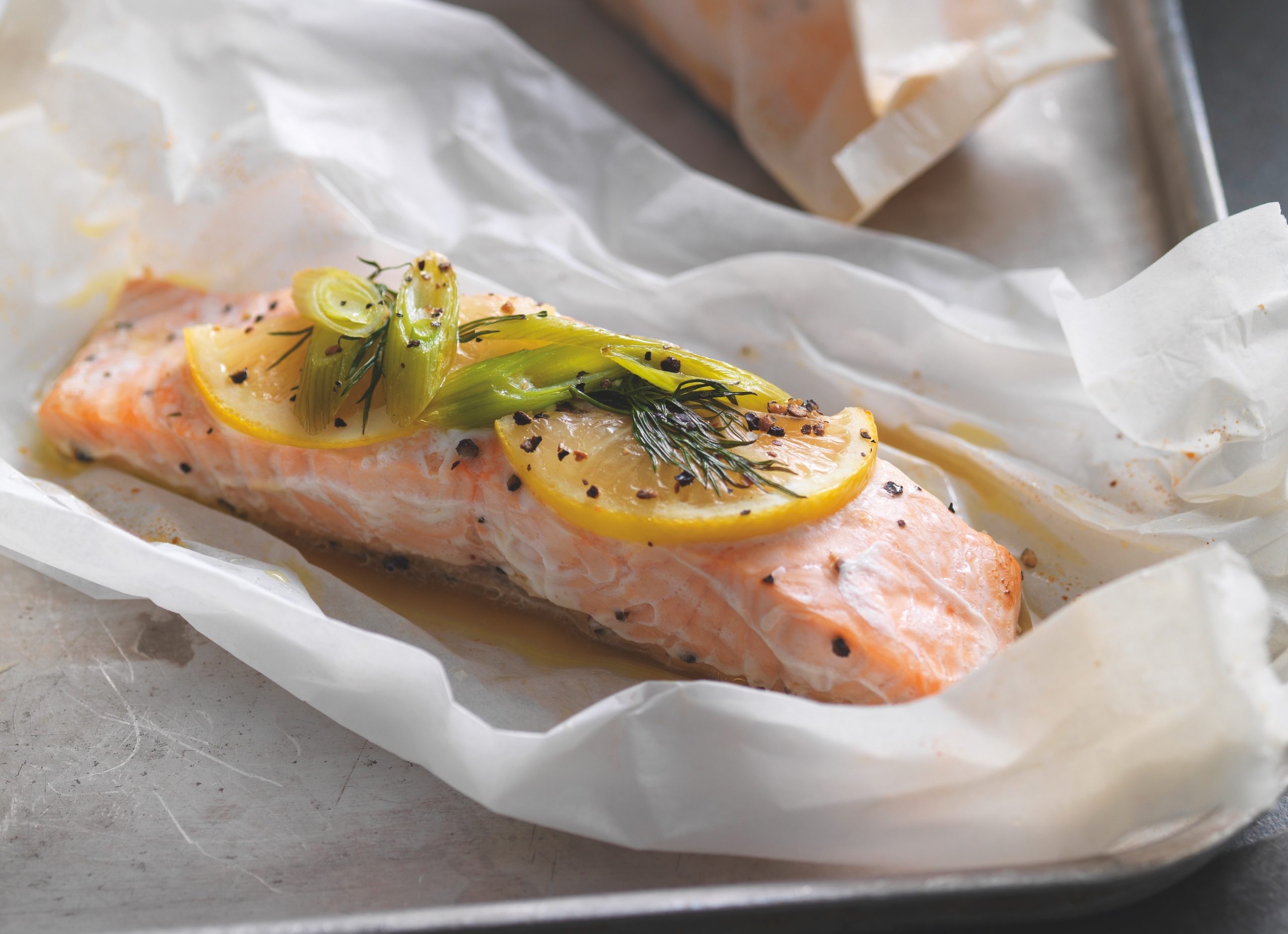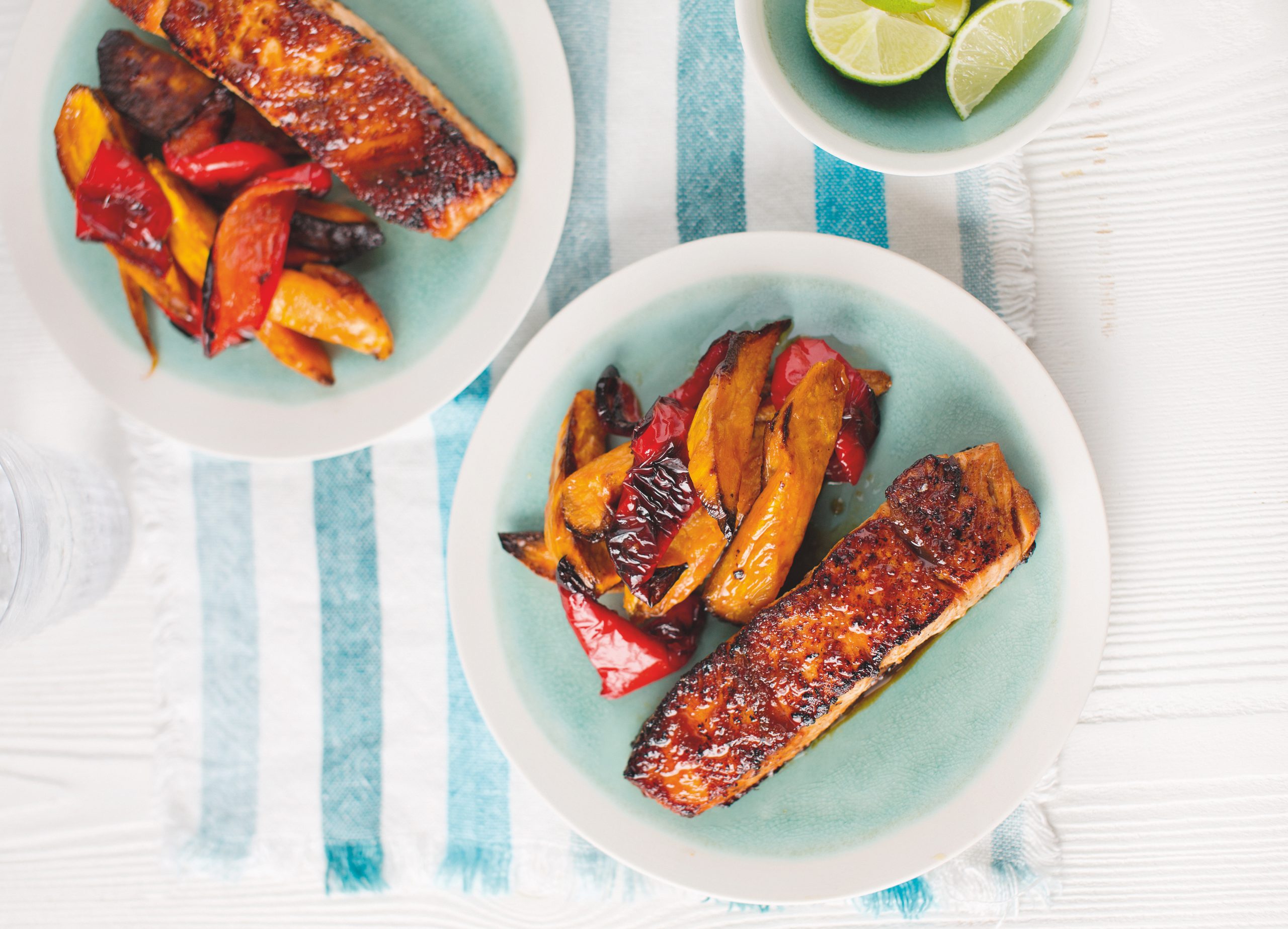How to cook salmon


From oven-baked to pan-fried, we've got everything you need to know about preparing and cooking salmon.
Salmon is a nutritious fish as its high in omega-3 fatty acids. If you have two portions of salmon a week you would achieve your recommended allowance of omega-3. The fatty acids in salmon can help to lower blood pressure and lower the risk of heart disease too.
As well as being high in omega-3, salmon is an excellent source of B vitamins. If you are a pescatarian (i.e. you eat fish and not meat) salmon is a great way to get your dose of vitamin B12. B vitamins are great for keeping your heart and brain health.
Salmon is a versatile fish that can be cooked in a variety of different ways. If you’ve not tried salmon before then you might want to try poaching it to keep it simple. Our Food Director, Elisa Roche, likes to poach salmon and then crumble it before mixing it through buttery noodles. Poaching will also reduce the amount of fat as you’re cooking it in water and then removing it from all the juices.
If you like food that’s full of flavour you can try marinating your salmon in a marinade of soy sauce, ginger, chilli, and honey for a couple of hours or overnight before frying it in a hot pan. Because salmon is a meaty fish and a flavoursome one, it can hold up to strong flavours.
*How to bake salmon *How to poach salmon *How to pan-fry salmon *How to BBQ salmon *How to cook salmon from frozen *How to prepare salmon *Can you eat salmon skin?
How to cook salmon
How to bake salmon
- Wrap the salmon up loosely in foil with herbs and lemon slices.
- Bake in the oven for 15 mins at 180C, Gas 4.
- Carefully take the salmon out of the parcel and eat it with salad or vegetables.
Because salmon can be served slightly pink in the middle you don’t need to roast it for hours. In an oven at 180C, Gas 4 you should get perfectly cooked salmon in 15-25 minutes depending on the method you use and how thick the cut is.
GoodtoKnow Newsletter
Parenting advice, hot topics, best buys and family finance tips delivered straight to your inbox.
Oven baking salmon in this way is a great way to cook it with other ingredients. Putting your salmon in a parcel with other ingredients such as greens, peppers or potatoes is a simple way of creating a delicious complete meal.
Do you wrap salmon in foil or paper when baking?
The technical name for wrapping salmon either in foil or in baking paper is ‘en papillote.’ When baking salmon you don’t have to wrap it in foil but there are some advantages to doing so. You can wrap it up with other vegetables so they all cook at the same time and your meal is effectively a ‘one-pot’ recipe.
Also, it keeps all the juices in one place so the salmon makes its own sauce. It’s still lovely served with a squeeze of lemon or a simple dressing but it’s not as necessary as if you were baking it or pan-frying it. If you are cooking frozen salmon this is a good method as it stops it from drying out.
How to pan-fry salmon
Pan-fried salmon is a professional way to cook this delicious fish. Our Food Director, Elisa, even likes to remove the skin after cooking and fry it separately to make it super crispy and extra-tasty.
Keeping the skin on whilst pan-frying means that you can prevent the outside of the salmon from becoming tough. The skin crisps up and the salmon stays lovely and juicy. It’s important to flavour the skin of the salmon as much as possible - salt, pepper, and chilli flakes are simple options. Our pan-fried salmon with lemon and chili crust is a great example. You can also marinate the salmon in stronger flavour such as soy sauce, ginger, or miso. Jamie Oliver likes to fry it with chorizo, olives, and basil in his simple 5 ingredients smoky chorizo salmon recipe.
- Place a nonstick frying pan on high heat, add a thin layer of vegetable oil to the pan and place the fillet in the pan, skin side down.
- Once you can see the colour of the skin change to a golden brown (usually after about 5 mins) carefully flip the fillet over and give it another 5 mins. The salmon should be slightly pink inside.
How to poach salmon
Poaching is the healthiest way to cook salmon as no fat is required for the process. The cooked salmon is also very versatile as it creates a tender and flaky texture that is delicious stirred into a Nicoise salad or served with sticky rice and a teriyaki sauce.
You can play around with the flavours in the poaching liquid depending on how you serve the salmon. We recommend always adding peppercorns and salt to the water but you could try adding in lime juice and spring onions, white wine, and celery or lemon juice and shallots.
- Bring a pan of salted water plus your chosen aromatics to the boil and once it’s bubbling turn it down to a simmer.
- Pop the salmon in and cook it for 8-10mins. Be careful not to boil it as it might flake apart.
How to BBQ salmon
Salmon holds up really well on a BBQ and it develops a lovely smoky flavour. We recommend using skin-on salmon, brushed with a little oil if you are cooking it directly on the grill to prevent the fish from falling apart (although you will need to give the grill a little clean afterward).
You can also make a parcel using tin foil, like when roasting it, and pop that on to the BBQ to let it steam in its own juices (and any flavourings you add).
If you’re trying to impress then you could also BBQ an entire side of salmon, if your BBQ is big enough to allow it. An average size fillet for one will take around 3 mins on each side. A whole side will obviously take much longer – around 10mins each side – and can be tricky to flip so you may want to cook it in en papillote.
For a more detailed guide on how to BBQ salmon read our feature on how to cook salmon on a BBQ

How to cook salmon from frozen
It is possible to use most of the methods listed above when cooking salmon from frozen however, you must make sure that it is cooked properly and all the way through. A useful tool for ensuring this is a cooking thermometer, we recommend that you invest in one if you tend to cook from frozen frequently. The internal temperature should be 50C.
If you are pan-frying then it’s best to defrost it completely first otherwise you will most likely burn the outside of the salmon before the inside is cooked. To defrost the salmon, place the fillets on a plate in the bottom of the fridge at the start of the day and it should have defrosted by the evening.
The best methods of cooking frozen salmon are to either poach it or bake it. Poaching is great as it ensures that the salmon doesn’t dry out with the extra cooking time that is necessary. An extra 5 mins per individual fillet should be enough but check the middle before serving.
You can also bake frozen salmon – if you do it en papillote you will find it won’t be as dry. Again, it will take longer to cook but 25-30mins should be enough time for an average one-person fillet (around 150g).
How to prepare salmon
How to prepare salmon fillets
Salmon fillets are the most low maintenance cut of the fish to buy, prepare and cook. They are available pre-cut at most supermarkets and fishmongers and are ready to cook from the packet. If you prefer a skinless fillet however you can ask your fishmonger to remove it for you.
The most important step in preparing the fillet for cooking is to first season it with salt. If you want to impart further flavour you could marinate it for a few hours prior to cooking.
If you are planning on pan-frying your fillet, which you can find instructions on below, it is good to use a kitchen towel to dry off any excess moisture as this will ensure crispy skin and stop the fish from spitting in the pan. Generally, you cook the salmon fillet as a whole, i.e. to poach or pay fry. However, you could prepare it in other ways; cutting the fillet into large dice to make salmon kebabs or blitzing the fillet up with aromatics to make salmon patties.
How to prepare a whole salmon
Serving a whole salmon is an elegant and delicious centerpiece for any buffet or dinner party. It could also be a good way to meal prep as the cost per kg of a whole salmon is cheaper than it is for pre-cut fillets - so you could cook the whole fish at the weekend and then use the flesh in sandwiches or salads for lunches and stir it into curries or stir-fries for dinners.
The whole salmon is a little harder to come to buy than fillets - you often need to order it from your fish counter or fishmonger a week in advance. It is worth remembering that the gills on the salmon will make the flesh taste bitter so either ask your fishmonger to remove these for you or use a pair of sharp scissors to cut them off at home.
There is not a lot of preparation that needs to be done before cooking a whole salmon. Simply follow the instructions in your chosen recipe for roasting or poaching it.
How to prepare a side of salmon
If the whole salmon seems a little ambitious you may want to get a side of salmon. This is half a salmon, removed from the head and bone. It can be cut into fillets, which again would be cheaper per kg than buying pre-cut fillets, or bought and cooked as a whole delicious slab of salmon.
There is not much preparation involved for a salmon side that has already been de-boned. You could ask your fishmonger to take the skin off and cut it down into fillets for you if you wish. If you are roasting it whole in the oven you should use a sharp knife to score the skin a few times, which will stop the skin from tearing when it is cooked.
As always, the key is to season with salt before cooking and to pat the salmon down with a kitchen towel to remove excess moisture and give a nice colour and crust to the flesh.
Can you eat salmon skin?
You can eat salmon skin. In fact, it’s one of the healthiest pieces of salmon to eat. The skin contains the highest concentration of omega-3 fatty acids which are essential fatty acids due to the body not being able to produce them. The skin is also really tasty, especially when crisped up from pan-frying.
Some people can be put off by the skin because it can be a little slimy if not pan-fried. Especially if it’s poached or cooked ‘en papillote’ as it doesn’t get a chance to crisp up. You can always remove the skin after cooking and fry it last minute with lots of salt and pepper.
If you buy your fish from a supermarket it will likely have already been prepared properly but if you’re buying from a fishmonger or you’ve caught it yourself just be sure to check that it’s descaled otherwise the skin won’t be edible.
Related video:

Former Assistant Headteacher, Samuel has a BSc in Food from the University of Birmingham and is also Co-Vice Chair of the Guild of Food Writers and a Trustee of 91 Ways CIC. His work has featured in national and international publications including Waitrose Food, Australian Delicious, and the LAD Bible Group. Samuel has also consulted on a number of best-selling food and drink books, and was a nutritional consultant for BBC’s Eat Well for Less.